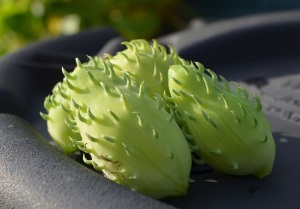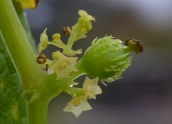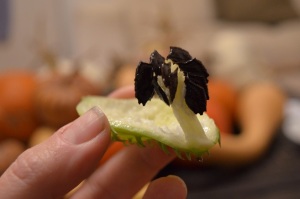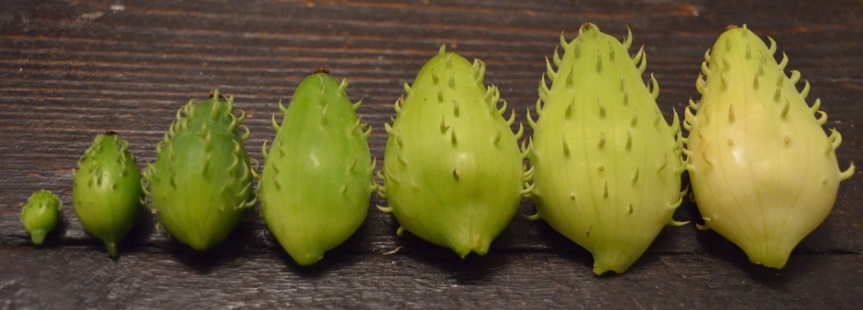Achocha
aka Fat Babies (Cyclanthera brachystachya)
 Achocha are fantastic multipurpose vegetables. When they are small you can eat them whole – crunchy and cucumbery in salads, stir-fries or as pickles. When they are larger they work really well as a green pepper substitute, which is handy given how difficult I find it to grow sweet peppers. And they are prolific, growing and fruiting right up till the frosts. Each spiky fruit weighs just a few grammes – 4 plants produced well over 4kg between early August and mid-November in 2014, just to give you an idea of what you get. Sow the seeds under cover in late April/early May on their sides and 1cm down in moist, free-draining soil. Or wait till the last threat of frost has gone and sow direct then.
Achocha are fantastic multipurpose vegetables. When they are small you can eat them whole – crunchy and cucumbery in salads, stir-fries or as pickles. When they are larger they work really well as a green pepper substitute, which is handy given how difficult I find it to grow sweet peppers. And they are prolific, growing and fruiting right up till the frosts. Each spiky fruit weighs just a few grammes – 4 plants produced well over 4kg between early August and mid-November in 2014, just to give you an idea of what you get. Sow the seeds under cover in late April/early May on their sides and 1cm down in moist, free-draining soil. Or wait till the last threat of frost has gone and sow direct then.
 Achocha are speedy climbers. They are frost-tender, so I plant them out on my South London allotment in late May/early June. At this stage they look deceptively frail and wispy. Do not be fooled – these plants will not be contained! The main vine of the plant splits octopus-like into a mass of stems and tendrils which look for something to grip onto and climb up.
Achocha are speedy climbers. They are frost-tender, so I plant them out on my South London allotment in late May/early June. At this stage they look deceptively frail and wispy. Do not be fooled – these plants will not be contained! The main vine of the plant splits octopus-like into a mass of stems and tendrils which look for something to grip onto and climb up.
Generally I grow them on the back of my shed (7ft wide x 6ft high) because it’s sheltered and sunny – and a narrow space that I don’t really know what else to do with. Four plants will happily cover that and then go off exploring around the edges, up the t ayberries, over the potted bay trees and twining through my pear trees on the other side. By August the achocha is generally fruiting, with separate male and female flowers that hoverflies love. Other than slugs which attack when the plants are very young, no pest or disease seems to bother them.
ayberries, over the potted bay trees and twining through my pear trees on the other side. By August the achocha is generally fruiting, with separate male and female flowers that hoverflies love. Other than slugs which attack when the plants are very young, no pest or disease seems to bother them.
As said above, the fruits are edible at any stage. The more you pick, the more the vines produce – and they grow FAST. The spines are soft and don’t need to be removed. When small, no bigger than a 10p piece, they can be eaten whole. Shortly after that the seeds start to harden and you need to deseed them to eat them.
I prefer to de-seed and cook the larger ones – the hard seeds aren’t tasty! They don’t take long to cook at all, just a couple of minutes if you’re frying them.  Achocha are South American and are related to exploding cucumbers, and the green ripe fruit does open very easily, as if there is some pressure inside. Overripe fruit is pale yellow/white. The seeds are curious – jagged black things. They are held on a central stalk inside the fruit, which develops in a cavity as the fruit gets bigger. It makes them very easy to remove. And if you like achocha, the plants will produce enough seed for you and anyone else who wants them.
Achocha are South American and are related to exploding cucumbers, and the green ripe fruit does open very easily, as if there is some pressure inside. Overripe fruit is pale yellow/white. The seeds are curious – jagged black things. They are held on a central stalk inside the fruit, which develops in a cavity as the fruit gets bigger. It makes them very easy to remove. And if you like achocha, the plants will produce enough seed for you and anyone else who wants them.

I too am growing these, this is my first year and I have them in the polytunnel as well as at the bottom of the garden again the garage. Am very much looking forward to the really hope they are as successful as you describe from your experiences.
LikeLike
You have them in a polytunnel? Oh. My. If my experience holds true for you, brace yourself for bushels of the things from early August! 🙂
LikeLike
Now you have me worried, do they freeze 😮
LikeLike
no idea – I forced nearly everyone I knew to have some. Think courgettes, but smaller…
LikeLike
Cool, I’m growing these little babies this year for the first time for a few years. Looking forward to the crop and hoping the kids will like them 🙂
LikeLike
I’ve got the giant ones this year, we’ll have to compare notes.
LikeLiked by 1 person
Sounds good. My first fruits are just forming…
LikeLiked by 1 person